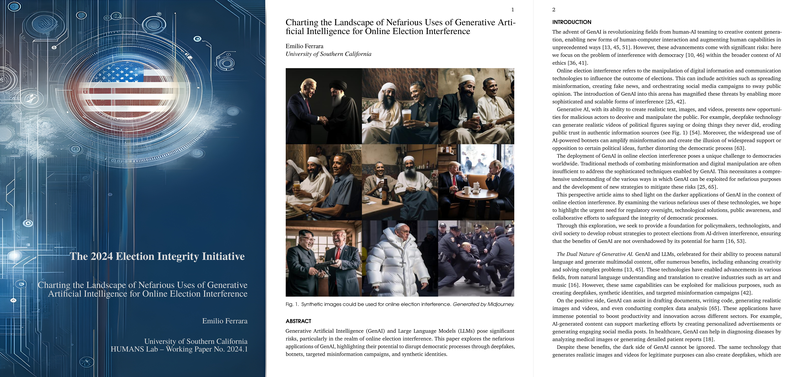Reviewing the 2024 Election Integrity Initiative: Charting the Landscape of Nefarious Uses of Generative Artificial Intelligence for Online Election Interference
Emilio Ferrara's working paper, "The 2024 Election Integrity Initiative: Charting the Landscape of Nefarious Uses of Generative Artificial Intelligence for Online Election Interference," provides a thorough exploration of how Generative AI (GenAI) and LLMs can be exploited to destabilize democratic processes. The paper stresses the urgency for regulatory and technological countermeasures to mitigate the growing threats posed by these advanced AI technologies.
Nefarious Applications
The paper explores several key areas where GenAI poses threats to election integrity:
- Deepfakes and Synthetic Media: AI-generated realistic videos and audio can mislead the public by depicting scenarios that never transpired. Deepfakes can severely damage reputations and create confusion among the electorate.
- AI-Powered Botnets: These networks of automated accounts can distort public opinion by amplifying misinformation, creating a false perception of widespread support or opposition. These bots become nearly indistinguishable from human users due to advanced AI capabilities.
- Targeted Misinformation Campaigns: By crafting messages tailored to specific demographic groups, AI-driven misinformation campaigns exploit societal divisions and influence voter behavior. This targeted approach increases the potency of these campaigns.
- Synthetic Identities: AI can generate highly convincing fake personas to infiltrate social networks, spread false information, and gather intelligence, undermining trust in online interactions and election processes.
Empirical Evidence
Through comprehensive tables (e.g., Table~\ref{tab:nefarious-applications}), the paper methodically categorizes the different ways AI can be misused for election interference, illustrating each nefarious application by its mechanism, impact, examples, and countermeasures. Moreover, historical instances of election interference, such as the 2016 U.S. presidential election and the 2017 French elections, are discussed to provide empirical context to the theoretical threats.
Societal Implications
Ferrara explores how these AI applications can erode public trust, exacerbate societal divisions, undermine democracy, exacerbate inequality, and even psychologically impact society. For instance, the bombardment of conflicting information can cause information overload, increasing stress and anxiety among the population. The paper highlights that these issues collectively pose significant risks to democratic institutions and social cohesion.
Mitigation Strategies
Addressing these concerns requires a multi-faceted approach:
- Regulation and Oversight: Effective governance and international cooperation are vital for establishing ethical guidelines for AI use. Regulatory frameworks should include transparency, accountability, and disclosure mandates for AI-generated content.
- Technological Solutions: Detection technologies such as digital watermarking and AI-driven systems can identify and mitigate the spread of AI-generated misinformation and bot activity.
- Public Awareness: Educating the public on discerning misinformation and critically evaluating information sources is crucial. Media literacy should be promoted to help citizens navigate the complexities of digital information.
- Collaborative Efforts: Multi-stakeholder initiatives can foster the development of best practices and shared standards for ethical AI use, with international cooperation being essential for a unified approach against AI-driven election interference.
- Ethical AI Development: Developers should prioritize fairness, accountability, and transparency in AI systems, including creating interpretable models to increase trust and ensure effective oversight.
- Legal and Policy Frameworks: Legal frameworks must encompass data protection and accountability for AI misuse, incorporating penalties for creating and disseminating malicious AI content.
Through these concerted efforts, Ferrara argues, the risks associated with GenAI can be mitigated to preserve the integrity of democratic processes.
Future Directions
The paper implicitly calls for future research and development to focus on advancing detection technologies and refining regulatory frameworks. It also underscores the importance of continuous public education on media literacy to keep pace with the evolving digital landscape. Collaborative international efforts remain pivotal in addressing these global challenges effectively.
Conclusion
Ferrara's paper illuminates the critical risks posed by GenAI in online election interference and emphasizes the need for comprehensive strategies to safeguard democratic integrity. It provides an empirical and theoretical foundation for policymakers, technologists, and civil society to develop robust countermeasures. The outlined measures, if adopted, can significantly contribute to the mitigation of AI-driven election interference, fostering a more secure and trustworthy electoral landscape.
